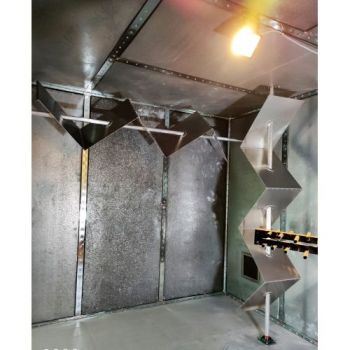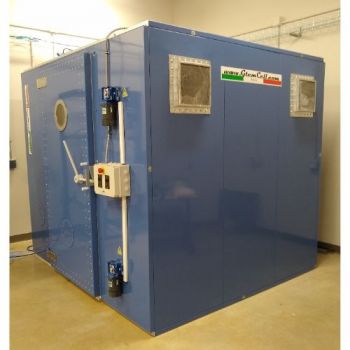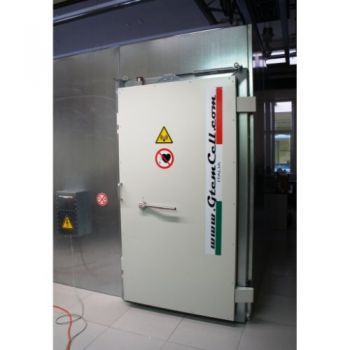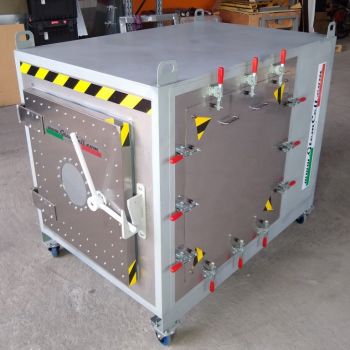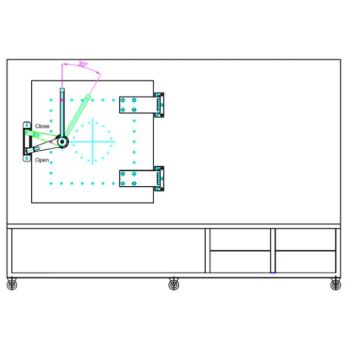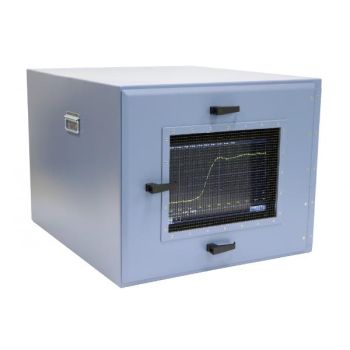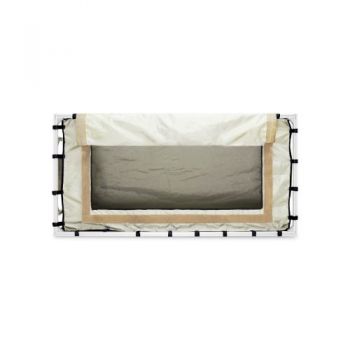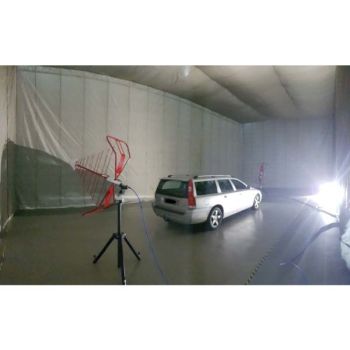
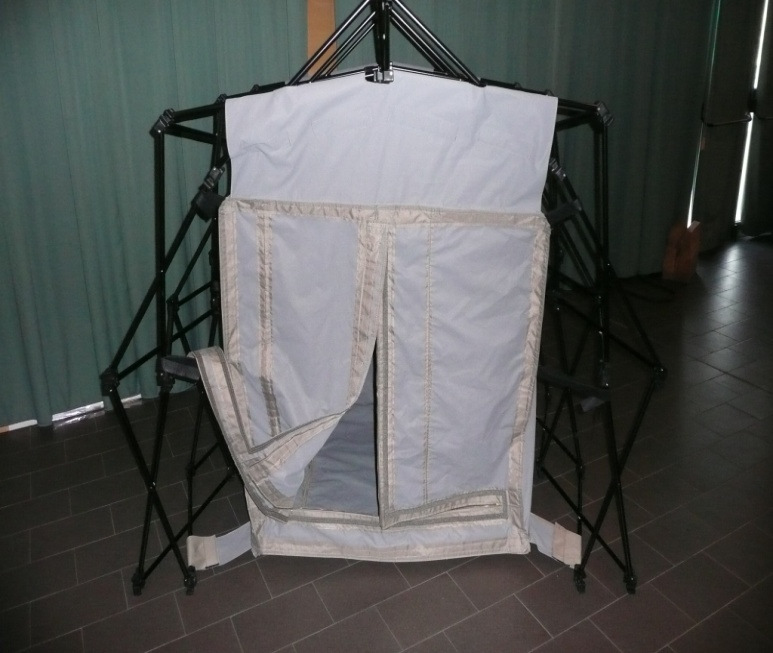



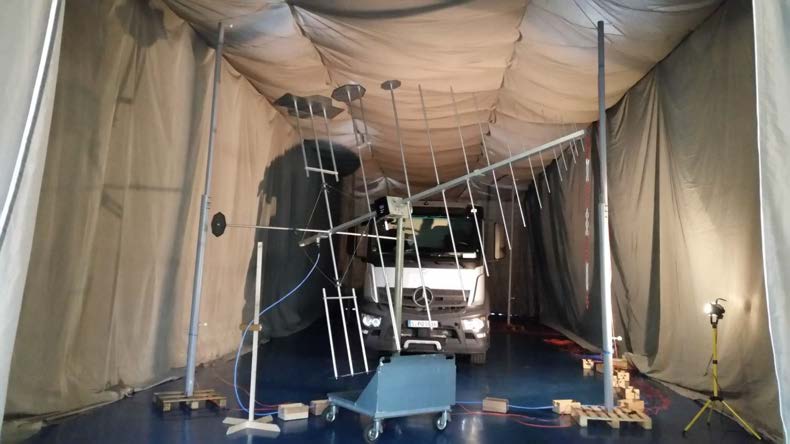
VRC Reverb Tent Chamber
VRC (Reverberation tent chamber)
This product is a chamber made of a flexible metal fabric tent assembled as a cavity that provides a periodic electromagnetic environment that is randomly polarized, spatially uniform, and isotropic.
The walls of the chamber are inducted in mechanical vibration between 5 and 20Hz, able to reflect the electromagnetic waves inside the tent with a reverberation effect. VRC finds applications to create an electromagnetic environment for immunity and emission testing. The reverberation tent chamber offers the advantage of higher field-to-input power ratios and faster test throughput times than other test methods.
The IEC 61000-4-21:2003 is a comprehensive standard for performing electromagnetic testing with a reverberation chamber.
The modular construction of the tent fabric allows customized dimensions assembly to meet space limitations e/o including the device under test. The VRC is supplied complete with a technical panel and optional filters.
PARTNER:
MARKETS:
- Automotive ,
- Avionics ,
- Military ,
- RF ,
- Space ,
- Wireless/Telecom ,
TEST STANDARDS:
Reverberation Tents
Over the past several decades, RCs have been enjoying growing popularity as a promising facility for the characterization of wireless devices and for EMC testing. The RC (Reverberation Chamber) measurement method exhibits much competitive superiority over the AC (Anechoic Chamber) method and TEM Cell methods, such as low cost, enhanced test repeatability, a more realistic test environment, and an easily achieved high-field environment. The application of the RC for performing EMC testing was first proposed by H. A. Mendes in 1968. In the recent IEC 61000-4-21 standard, the importance of EMC testing using RCs as an alternative measurement technique has been recognized. An electromagnetic reverberation chamber is a multifunctional EMC (Electromagnetic Compatibility) test facility for commercial, military, automotive testing, and other electromagnetic investigations. Also known as reverb chamber (RVC) or mode-stirred chamber (MSC) or, Vibrating intrinsic reverberation chamber (VRC). A reverberation chamber is a screened room with a minimum absorption of electromagnetic energy. Due to the low absorption of the walls, very high field strength can be achieved with moderate input power. A reverberation chamber is a cavity resonator with a high Q factor. Thus, the spatial distribution of the electrical and magnetic field strengths is strongly inhomogeneous (standing waves). To reduce this inhomogeneity, different techniques are applied:
- Generating reverberation through one or more tuners (stirrers) in movement.
- Vibrating the walls of a shielded tent. (VRC)
A tuner is made with large metallic reflectors that can be moved to different orientations in order to achieve different boundary conditions. The VRC is basically a tent made with a special metalized shielded flexible fabric assembled as a cavity that provides a periodic electromagnetic randomly polarized, spatially uniform and isotropic facility. The walls of the tent are inducted in mechanical vibration between 5 and 20Hz, able to reflect the electromagnetic waves inside the tent volume with a reverberation effect. The VRC finds applications in creating an electromagnetic environment for immunity and emission testing, it offers the advantage of faster test throughput times than other test methods, increasing the uniformity levels. The VRC is easy to mount and can be quickly assembled and disassembled directly at the customer’s place in a few hours!. It allows testing of large systems/installations with a VRC and overcomes space limitations by also incorporating big devices under test. The Lowest Usable Frequency (LUF) of a reverberation chamber depends on the size of the chamber and the design of the tuner. Small chambers have a higher LUF than large chambers. The chambers RVC are made of modular 2 mm thickness galvanized steel or 3mm. aluminum panels system. In addition to our standardized models, all chambers are available in customized dimensions according to individual requirements. All the Gtemcell stirrer systems are compatible with software by Nexio, Teseq, and Rohde & Schwarz. The stirrer systems can be controlled using a standard office PC or lab top. GTemcell can offer the reverberation chamber as a turnkey solution,, including software, operational verification, and after-sales service support.
Applicable standards/test methods for the reverberation Tents.
- IEC 61000-4-21:2003
- MIL-STD-461-E&F
- RTCA/DO-160-G
- EUROCAE/ED-14F
| Reverberation Tents | |||||||
| Lowest frequency usable | External Dimensions | Usable test volume | Vibration system | Note: | |||
| 700VRC | 700MHz-18GHz | L1.2xW1.2xH1.2m | L0.5xW0.5xH0.5m | VRC, Vibrations of the 5 walls | Metalized fabric | ||
| 400VRC | 400MHz-18GHz | L3xW2xH2m | L0.8xW0.8xH0.8m | VRC, Vibrations of 5 walls | Metalized fabric | ||
| 400VRC -HY | 400MHz-18GHz | L2.50xW2xH2m | L0.8xW0.8xH0.8m | VRC, Vibrations of 4 walls | Hybrid: Metalized fabric + metal base and front door | ||
OPTIONS:
|
|||||||


